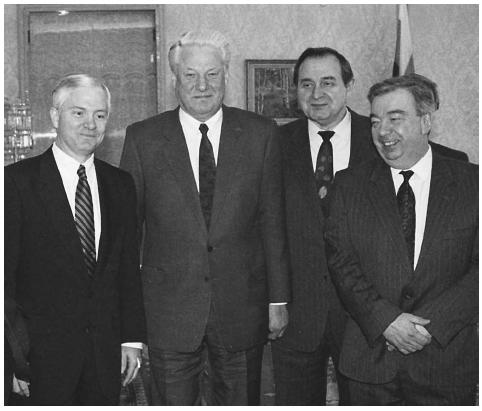Bush Administration (1989–1993), United States National Security Policy
█ CARYN E. NEUMANN
The administration of President George H. W. Bush confronted the most fundamental changes in the national security environment since the onset of the Cold War in the 1940s. The collapse of the Soviet Union and the disintegration of the Soviet empire removed the threat of communism that had long determined the direction of security efforts. To respond to this changed environment, Bush reduced the size of the military, shifted resources to the war on drugs, and pursued a new world order that included access to the oil-rich Persian Gulf states. This last goal made imperative the removal of Iraqi forces from Kuwait after it was invaded by Iraq, and resulted in the U.S. coalition-led Persian Gulf War with Iraq.
Bush, a former director of the Central Intelligence Agency, entered the White House after serving as vice president to Ronald Reagan. His approval of Reagan's security policies meant that he would largely continue them as president. The appointment of General Brent Scowcroft, National Security Adviser during the Ford administration, brought deep experience to the National Security Council (NSC) leadership. James Baker headed the State Department. The Department of State and the NSC worked harmoniously, with the jealous guarding of territory that had marked earlier administrations notably absent from this administration.
Reagan had issued a 1986 directive that characterized illegal drugs as a national security threat. The Bush administration expanded this initiative in 1989 with National Security Directive (NSD) 18. This two-part NSD designated the Department of Defense as the lead agency for the detection and monitoring of the aerial and maritime transit of illegal drugs into the country. While there are few specifics in the document, implementation of the directive almost certainly included increased use of intelligence resources, specifically more extensive use of U.S. reconnaissance satellites to locate coca-growing laboratories, communication intercepts to identify drug-smuggling planes entering the country, and other efforts to help monitor the communications of major drug cartel leaders. The second part of the NSD, named the "Andean Initiative", called for foreign aid for Columbia, Bolivia, and Peru with most of the assistance coming in the form of military equipment, such as helicopters, patrol boats and ammunition. The NSD also included such intelligence aid as radars, electronic sensors, secure communications equipment, and computers to store and retrieve information about drug traffickers.
Along with freeing resources for the war on drugs, the end of the Cold War also brought a renewed emphasis on arms control. The collapse of the Soviet system had left a considerable amount of military hardware in Europe and Bush saw arms control as a way of reducing the risks associated with this weaponry. The Conventional Forces Europe (CFE) agreement in 1990 covered the area from the Atlantic Ocean to the Urals. The North Atlantic Treaty Organization (NATO) forces and the recently Soviet-aligned divisions of the Warsaw Treaty Organization (WTO) were limited to 20,000 tanks; 30,000 armored combat vehicles; 20,000 artillery pieces; 2,000 helicopters; and 6,800 combat aircraft. These figures meant marginal cuts for NATO countries, but substantial cuts for WTO states. The result was parity in conventional military forces. CFE served as a major symbol of the end of the Cold War by speeding the demilitarization of Europe.
The dependency of the United States upon oil made access to the Persian Gulf a vital matter of national security. In NSD 26, Bush ordered federal agencies to expand political and economic ties with the Saddam Hussein regime of Iraq to ensure the continued friendliness of the dictator. This 1989 directive led to U.S. government loan guarantees that enabled Iraq to purchase vital foodstuffs on credit and divert hard currency reserves to finance a massive arms buildup. In 1990, Iraq used these arms to support an invasion of Kuwait. The resulting Persian Gulf War succeeded in freeing Kuwait from Iraq's grasp, but U.S. national security interests were damaged in the long term by allowing Hussein to remain in power.
█ FURTHER READING:
BOOKS:
Williams, Phil and Dilys M. Hill, eds. The Bush Presidency: Triumphs and Adversities. New York: St. Martin's Press, 1994.
ELECTRONIC:
Digital National Security Archive. "Presidential Directives on National Security from Truman to Clinton." < http://nsarchive.chadwyck.com/pdessayx.htm > (April 25, 2003).
SEE ALSO
Cold War (1972–1989): The Collapse of the Soviet Union
National Security Strategy, United States
NATO (North Atlantic Treaty Organization)
NSC (National Security Council)
Persian Gulf War

Comment about this article, ask questions, or add new information about this topic: